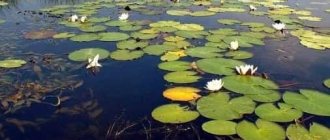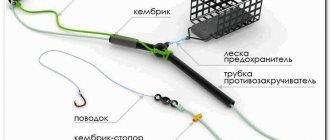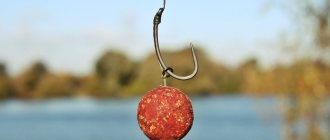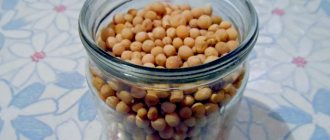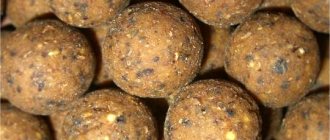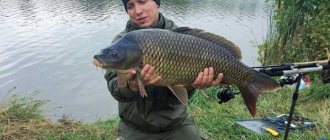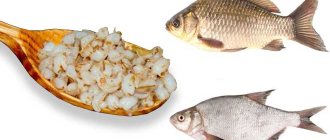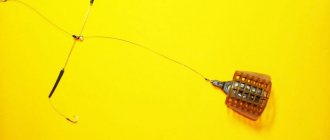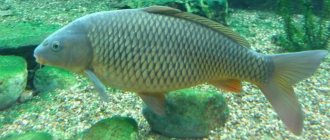Anglers love to go after carp and use various methods to do this. True, lately there has been increasing demand for carp fishing with a nipple, which gives good results. This method can be used by both experienced and beginners.
A nipple tackle is a design that can be used to catch fish of various sizes. It must be said that sometimes the equipment that is chosen is not enough. You also need to know how it works.
It often happens that the gear is good, but there is no use because the fisherman picked the wrong bait. Therefore, you should pay attention to this nuance, and also know where to catch carp and how to do it correctly.
How the tackle works
By design, the pacifier can be compared to a cylindrical or conical spring, which consists of:
- Carbine.
- Hooks (there can be 5-7 of them).
If we talk about the latter, it is worth noting that in most cases preference is given to forged elements. As for leashes, a nylon cord is used.
Important! Braided or regular fishing line is not suitable for the presented type of gear.
Today it is not a problem to purchase the product in specialized stores, although most people make it with their own hands.
In order to do everything yourself, you need to arm yourself with the simplest parts that almost every angler has in their arsenal:
- Stainless steel wire.
- Nylon cord.
- Kryuchkov.
- Carbine.
To wind the spring, you must use a wooden cone or bolt. The size of the finished spring should be in the range of 4-6 cm. In diameter, this mark is 3 cm. It is not uncommon for fishermen to use ready-made elements.
At the next stage, hooks are attached to the leashes. The elements are passed through a hole made in the cambric. Next you will need to align the hooks and make a loop - you will need to attach a carabiner to it. The spring is attached to the main leash, which is passed through it. Having done all this, we can assume that the carp nipples are ready.
Many people are perplexed why a spring is used in the tackle and what its role is. Although everything is extremely simple, the element is necessary to hold the dough, which fish bites so well on.
Design features and mechanism of action
The fishing tackle described is a feeder with a special type of shape. One of the ends of the main fishing line is tied to it. In addition, leashes with hooks must be attached. Usually they are fixed to the feeder or fishing line itself. As a nipple filler, choose a bait with a sufficient level of viscosity that masks the hooks. Sometimes the latter may contain foam balls or carp-attracting bait. The fish, sensing the smell, swims to the part of the lake where the nipples are located and begins to eat the bait, which ends with swallowing the hook. The course of further events depends on the chosen fishing method. If it is passive, then self-hooking plays the main role: after some time has passed, the fisherman checks the gear and takes out carp that are securely hooked. If a more active method is preferred, then you need to use a bite alarm. As a rule, in such cases, baits that are especially popular with carp are put on the hooks: worms, maggots, corn kernels. At the right moment, the fisherman hooks and then fishes out the fish. It is the latter method of fishing with a nipple that is considered more exciting and has the features of carp fishing.
What is the correct rig
The nipples can have several types of equipment: fishing with a spring (many people resort to this method) and fishing with a regular feeder.
The feeder method has a feeder weight that slides and resembles a spring in appearance. To create the equipment, you will need to take a carp fishing line with a cross-section of 0.3 mm. If you want to make a product with a short wire, then use a meter-long fishing line, at the end of which a loop is tied. Next, a tube made of PVC (about 6 cm in size) and a stopper made of rubber are put on the thread.
At the final stage, you need to put on the spring and carabiner. The latter is necessary to be able to quickly replace the gear. The length of the equipment, if everything is done as described, will not exceed 30 cm.
If desired, you can also make a long leash; in this case, either a twist (10-15 cm in size) should be made right in front of the reel, or an anti-twist should be installed. To secure the leash, it is allowed to use the loop method.
There is also a blind method of rigging for carp, it’s like this:
- A pair of hooks are attached next to the spring.
- Baits or baits are placed on hooks.
- The feeding mixture must be made from those components that are part of the bait or attachment.
- When filling the feeder, remember that you need to put hooks in it. This is necessary so that a hook occurs at the moment when the fish grabs the treat washed out of the feeder where the hooks are hidden.
Fishing technique
After the nipple has been made and the bait for it has been prepared, you can think about how to use it all correctly so as not to be left without a catch.
- First of all, the fisherman needs to decide in which place the fishing will take place. The best conditions for this are changes in depth, elevations on the bottom, and areas where aquatic vegetation begins and snags are located. The easiest way to understand what the terrain is like is to use a marker float or a spinning rod with a jig head.
- Having found a promising place for fishing, you should start rigging. Before throwing the tackle, stands are placed in the chosen place, bite alarms, landing nets and cages are laid out.
- Next they move on to preparing the nipples. The bait is placed in it so that water cannot quickly wash it away. To do this, it needs to be compacted well. After placing the bait in it, you need to create places for hooks - the so-called “nipples”, which have a convex shape. After this, you can cast the tackle.
- When the tackle is in the water and the rod is placed on the stand, you should adjust the line tension and install a bite alarm.
When fishing for carp or carp on a nipple, it doesn’t hurt to supplement the tackle with a baitrunner system. Thanks to it, the rod will not end up in the water if the fish suddenly pulls the line to the bottom. If the reel does not have such a device, proceed differently: you need to make sure that the friction brake is weakened to the limit.
What kind of porridge should I prepare for the nipple?

Despite the fact that the nipple is a fairly simple tackle, there are many nuances regarding the bait for the feeder.
Important! A properly prepared treat can be kept in water for up to 12 hours.
Many fishermen make the porridge too sticky, not realizing that the hooks get stuck in such a consistency. There is no need to make the bait too hard. If you want to achieve the desired consistency, it is recommended to cook the millet in a water bath. Readiness will be indicated by grains that crush easily in your hand.
After preparation, the bait is ground until smooth, and then semolina is added there. Some fishermen use boiled potatoes as bait. By the way, carp are sometimes caught using potatoes, and the vegetable is used as bait.
Everything is done in the following sequence:
- Several potatoes are boiled.
- Next, the potatoes are peeled and ground together with black bread in a meat grinder.
- Then add a little grated garlic to the resulting mass and mix it all thoroughly.
This delicacy can be stored in the refrigerator for up to four days.
Where to find carp
Having dealt with nipples for carp fishing, it is worth noting that you also need to know where to look for it. Some fishermen who sit in one place for a long time do not understand why there is no bite, but it is not because the cautious fish has left.
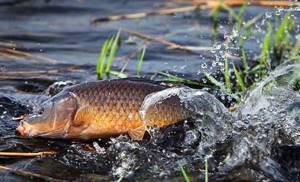
Important! If there are a lot of carp fishermen in one area, it is better to move away from them, because carp will not be found there.
Fish loves areas where there is a lot of air, where some kind of funnels are noticeable on the surface, which will indicate the presence of carp there. If there are cluttered areas or snags in the reservoir, you can get as close to them as possible, since fish like such areas where they live and hide.
It must be said that it is also very important to pay attention to weather conditions. Experienced people note that it is good to go after carp in windy weather when it is active. On a sunny day, you can sit for a long time and wait for a fish that won’t swim to no avail.
Search for carp
As has been emphasized more than once, carp is a very cautious fish. If you managed to catch him or a carp in the same place, he will definitely associate it with a signal of threatening danger and leave it.
The best way to find a place where there is a high probability of carp is to visually observe the surface of the water. Many experts in fishing for this particular type of fish recommend spending some time looking around the pond with binoculars before fishing.
Pay special attention to where fish are supposed to feed. Where she feeds, the bubbles rise from under the water slowly and they are quite static.
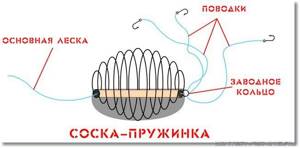
Remember the pressure factor from other fishermen. Possessing very good hearing, cyprinids will prefer to move to the middle of the reservoir or to even more secluded places due to the constant noise and splashes.
Cold and heat also significantly affect the movements of carp. Due to the heat and well-warmed water, fish can migrate to shallow water.
Very appreciative of privacy and the appearance of security, carp can often be caught near islands, under cover of aquatic plants, in reeds, and so on.
Carp and carp are very picky fish. This should be taken into account when selecting bait. It is precisely in order to “please” the fish that it is recommended to add pieces of bait of different types.
If you are serious about carp fishing, it is strongly recommended that you prepare your own bait rather than buy ready-made bait. This is what will allow you to experiment with components, selecting them most optimally.
How to fish with a nipple
Fishing with a nipple is very easy. First you need to find a suitable place, then pour pre-prepared porridge or some other delicacy that was previously created into the feeder. In addition, it is necessary to insert all the hooks into the feeder and carefully cover them with food. Having completed all these steps, you can safely throw the product into the water. When the fish starts to eat the food, it hooks itself.
At night, in order not to miss a bite, you should install a small bell on the rod.
The presented tackle should be used at a reservoir depth of one meter or more. It will not work in shallow water areas. If you want to achieve success, then it is advisable to use several nipples at a time on different rods.
The mistake many fishermen make is that they make bait that is not very appetizing and that the fish don’t want to bite on. Some beginners overcook the porridge or don’t pay attention when it burns a little, but the carp won’t swim to that, not to mention any bites. To make the delicacy more tasty, you can add a little honey or vanilla to it.
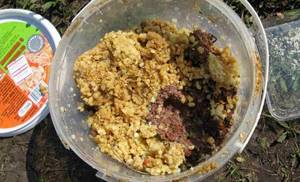
River inhabitants also respond well to the most common dough, which contains flour, water, flour and semolina, mixed in equal parts. However, the caveat is that if such food for carp lies even a little warm or in the refrigerator, it may refuse to peck at it. The product must be fresh, prepared just before leaving.
Sometimes fishermen are surprised that they can catch not only carp with a nipple, but also roach, crucian carp, silver carp, grass carp, etc. This is quite normal.
When is the best time to catch carp on a nipple?
Now that we have figured out what types of this gear there are, and also learned the nuances of fishing techniques, we will touch on another important topic - when is the best time to fish with a nipple.
Most carp fishermen fish with this type of gear throughout the open water season. And quite successfully. However, it is best to catch carp on a nipple in the summer (if the weather is warm, then until the end of September) after the end of spawning. At this time, the fish becomes more active. She responds with pleasure to unusual and tasty complementary foods.
In spring and late autumn, fishing for carp using a nipple is less effective. This is explained by the fact that fish are more interested in protein foods. Whereas the bait in the feeder for the nipple is made from plant ingredients - cereals, cereals, flour, macadamia, etc. Therefore, the most effective fishing with this tackle is considered to be in the period “June-September”.
Making nipples for carp
Many anglers make a pacifier from a plastic bottle. Tools can be made in different ways. So, some take a ready-made feeder, which is sold in the store, while others make it themselves.
If the element was purchased in advance, then you will only need to tie and then hide the hooks on which the foam is placed.
It should be understood that if you use a feeder from which the sinker is suspended downward, then the element will quickly go to the bottom with the lower part, and the upper part, on the contrary, will be open and allow the carp to freely gobble up the prepared delicacies. Such equipment will also prevent the feeder from turning over while sinking to the bottom. The presented product involves the use of two hooks.
As for foam plastic, it is also used to ensure that the hooks are at the top, as if floating up and holding on to the surface. Without this material, the elements will fall to the very bottom and the carp, even if it wants to (and it obviously won’t do this), will not reach them.
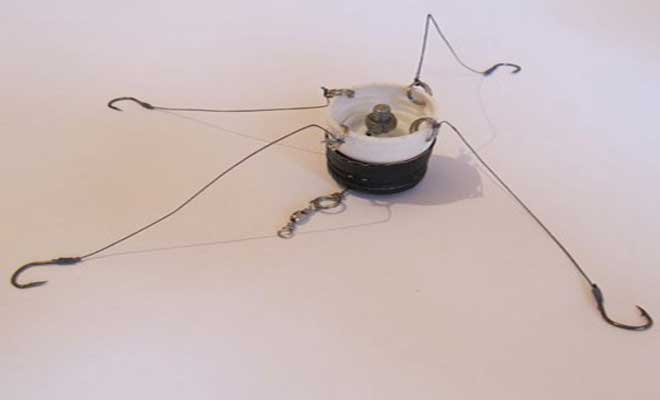
As already mentioned, you can completely make the pacifier yourself. For these purposes, you can use bottle caps on which leashes, weights and hooks are hung.
About the types of nipples for carp fishing
The first of the varieties is represented by a plug nipple. Its main component is made from the cap of an ordinary plastic bottle. Making such a feeder is not difficult. First, take a plastic stopper and securely attach leashes with hooks and sinkers to it. You will also need to cut a small hole, which is needed for the main line to pass through. If you decide to use this type of nipple when fishing for carp, then remember that when you get to the bottom of the reservoir, the sinker is at the bottom, and the bait, where the hooks are hidden, is on top.
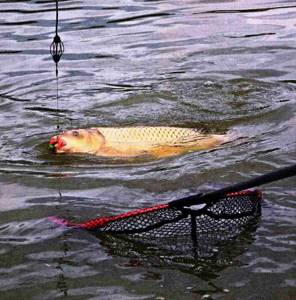
The second of the varieties is the spring nipple. There are two types depending on the mechanism used:
- A nipple called a “bagel” works thanks to a long, even spring twisted into a ring;
- The nipple, called a “harvester,” works thanks to a cone-shaped spring.

